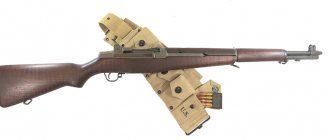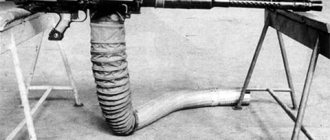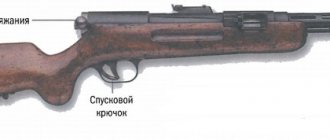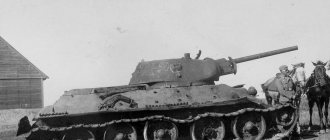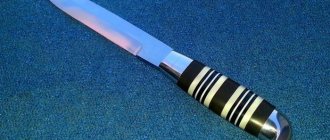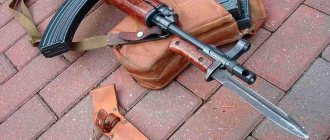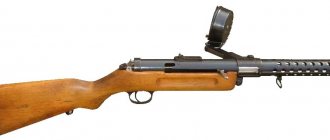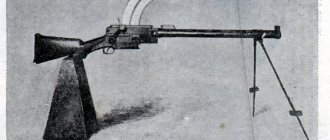During the Second World War, machine guns became the main destructive force of small arms at medium and long combat ranges: among some shooters, self-loading rifles were gradually replaced by submachine guns instead of self-loading rifles. And if in July 1941 the rifle company had 6 light machine guns, then a year later - 12, and in July 1943 - 18 light machine guns and one heavy machine gun.
Machine guns of the USSR army during the Second World War
The Red Army began World War II with two types of machine guns. The first is the well-known “Degtyarev Infantry”, designated DP. This weapon has a disc magazine with a capacity of 47 rounds. The cartridge supply system turned out to be quite good. Rim-cased cartridges often caused delays in firing guns with box magazines. A large flat single-row disk magazine with a spring feeder eliminated double feeding of the cartridge. The magazine originally had a capacity of 49 rounds, then it was reduced to 47 to reduce the likelihood of misalignment.
Degtyarev light machine gun (DP-27)
In 1944, a modernized version appeared - a DPM with a replaceable barrel, which could be removed using a special screwdriver. The recoil spring was placed in a tube under the barrel to reduce the chance of it overheating, which had previously caused it to weaken.
DPM machine gun
Tank modifications of the DP and DPM machine guns received the designations DT and DTM, respectively. Despite their age, DP and DPM machine guns can still be found in some areas of the world.
DTM tank machine gun
The second machine gun that was used during the Second World War, which had proven itself since the First World War, was the Maxim, model 1910/30, modified for a heavier bullet weighing 11.8 g. Compared to the 1910 model, its design about 200 changes were made. The machine gun has become lighter by more than 5 kg, and the reliability of the automation has increased. It was located on Sokolov's wheeled machine.
Machine gun "Maxim" model 1910
The specifics were the use of fabric tape and water cooling of the barrel. The machine gun itself weighed 20.3 kg (without water); and together with the machine – 64.3 kg. The Maxim machine gun was a powerful and familiar weapon, but at the same time it was too heavy for maneuverable combat, and water cooling could cause difficulties when overheating: fiddling with canisters during combat is not always convenient. In addition, the Maxim device was quite complex, which was important in wartime.
The question of replacing the Maxims with a more modern design remained, and in October 1943, 7.62-mm heavy machine guns of the Goryunov system of the 1943 model (SG-43) began to enter the troops. It is interesting that Degtyarev honestly admitted that the SG-43 is better and more economical than his design - a clear demonstration of the difference between competition and competition.
Goryunov machine gun (SG-43)
The Goryunov heavy machine gun turned out to be simple, reliable and quite light, but production was launched at several enterprises at once, so that by the end of 1944, 74 thousand units were produced.
Japan
The Type 11 entered service in 1922 and remained in service until 1945. The authorship officially belongs to General Kijiro Nambu, and it was under the name “Nambu” that he became famous.
This machine gun used a unique power system, which was not used in any other model. The idea was that the receiving device on the left side of the receiver was filled with cartridges, both single and in standard five-round clips, which did not require the creation of special magazines or cartridge belts.
But in practice, this advantage was overshadowed by the fact that the internal mechanism turned out to be too fragile and complex, often unable to withstand intense shooting with a conventional rifle cartridge. In addition, the same cartridge lubrication system added problems. which, as usual, in dusty conditions significantly hampered the operation of the mechanisms.
Only automatic firing machine gun TYPE 11
The Type 11 machine gun could only fire automatically, and when firing, the cartridge funnel made the entire system unbalanced and awkward. A special modification was developed - a Type 91 tank machine gun with a funnel for 50 rounds for installation on armored vehicles. The weaknesses of the Type 11 machine gun were revealed fairly quickly during the first battles in China in the 1930s, and in 1936 a new Type 96 light machine gun appeared.
Although the Type 96 was a significant improvement over its predecessor, it did not completely replace it, since the Japanese arms industry was unable to produce the required number of weapons of any type. The Type 96 was a combination of elements from the Hotchkiss machine gun and the Czechoslovakian ZB vz. 26.
From the latter, he took a top-mounted magazine, but the cartridge lubrication system remained, and accordingly, the problem of “clogging” the mechanisms with dirt remained. At the same time, the process of changing the barrel was noticeably simplified, and a telescopic sight was installed. However, soon such a sight began to be installed only upon request, but they left a convenient device for equipping a store. One of the features of the Type 96 machine gun was the bayonet mount.
Light machine guns "type 11" and "type 96" characteristics:
- Light machine gun "type 11"
- Caliber: 6.5 mm
- Weight: 10.2 kg
- Overall length: 1105 mm
- Barrel length: 483 mm
- Initial bullet speed: 700 m/s
- Rate of fire: 500 rounds/min
- Magazine: 30 rounds
Light machine gun "type 96"
- Caliber: 6.5 mm
- Weight: 9.07 kg
- Overall length: 1054 mm
- Barrel length: 552 mm
- Initial bullet speed: 730 m/s
- Rate of fire: 550 rounds/min
- Magazine: box, 30 rounds
Machine guns of the German army during WWII
Many experts specializing in the field of small arms consider German machine guns to be the best of those used in World War II. In this case, we are usually talking about machine guns MG 34 and MG 42.
The MG-34 machine gun was adopted by the Wehrmacht in 1934. It was the main machine gun until 1942 in both the Wehrmacht and tank forces. A special feature of the design is the ability to switch power to feed the tape both from the left and from the right, which is very convenient for use in armored vehicles. For this reason, the MG-34 was used in tank forces even after the appearance of the MG-42. The disadvantage of the design is the labor and material consumption of production, as well as sensitivity to contamination.
MG-34 machine gun
An unsuccessful design among German machine guns was the HK MG-36. The relatively light (10 kg) and easy-to-manufacture machine gun was not reliable enough, the rate of fire was 500 rounds per minute, and the box magazine contained only 25 rounds. As a result, it was first armed with Waffen SS units, supplied on a residual basis, then it was used as a training weapon, and in 1943 it was completely withdrawn from service.
HK mg36 machine gun
The masterpiece of German machine gun engineering is the famous MG-42, which replaced the MG-34 in 1942. Compared to the MG-34, the designers were able to reduce the cost of the machine gun by approximately 30%, and the metal consumption by 50%.
MG-42 machine gun - “Hitler Circular”
Production of the MG-42, nicknamed “Hitler's circular machine,” continued throughout the war; in total, more than 400 thousand machine guns were produced. The machine gun's unique rate of fire made it a powerful means of suppressing the enemy, however, as a result, the MG-42 required frequent replacement of barrels during combat. At the same time, on the one hand, changing the barrel was carried out structurally in 6-10 seconds, on the other hand, it was possible only with the presence of heat-insulating (asbestos) mittens or any improvised means.
In the case of intense shooting, it was necessary to change the barrel every 250 shots: if there was a well-equipped firing point and a spare barrel, or better yet two, everything was great, but if it was not possible to change the barrel, then the effectiveness of the machine gun dropped sharply, firing could only be carried out in short bursts and taking into account the need for natural cooling of the barrel. The MG-42 is deservedly considered the best machine gun in its class of World War II.
The Mauser MG-81 machine gun of the 1939 model was also used to a limited extent by the Germans. Initially, the MG-81 was used as an on-board defensive weapon for Luftwaffe bombers; it began to enter service with airfield divisions in 1944. The short barrel length caused a lower muzzle velocity compared to standard light machine guns, but the MG-81 had less weight.
But for some reason the Germans did not bother with heavy machine guns in advance. Only in 1944 did the troops receive Rheinmetall-Borsig MG-131 machine guns of the 1938 model, which are also of aviation origin: when the fighters were converted to 30-mm MK-103 and MK-108 air guns, the MG-131 heavy machine guns were transferred to the ground forces (total 8132 machine guns).
Rheinmetall-Borsig MG-131 machine gun
Thus, we can say that in general, from a design point of view, the Reich and the USSR had parity in machine guns. On the one hand, the MG-34 and MG-42 had a significantly higher rate of fire, which in many cases was of great importance. On the other hand, they required frequent barrel changes, otherwise the rate of fire remained theoretical.
In terms of maneuverability, the old “Degtyarev” won: the inconvenient disk magazines nevertheless allowed the machine gunner to fire alone.
Italy
Breda machine guns
The 1930 model machine gun turned out to be one of those weapons that, to put it mildly, can be classified as unsuccessful. Externally, it consisted of corners of protrusions, and therefore it was a real torment for the machine gunner to carry it, because all these protrusions clung to clothing and equipment. In addition, the designers developed a new power system using 20 charging clips, which are fragile and brittle. These clips were inserted into a folding magazine, which had a very delicate mount, and if the magazine or mount was damaged, the machine gun could not be used.
Finally, the real problem was the extraction of spent cartridges, which necessitated the installation of an oil pump to lubricate and facilitate removal of the cartridges. Theoretically, this should have worked, but the oil, mixing with dust and dirt, especially in North African conditions, completely clogged the mechanism. Against this background, the lack of a handle for changing the barrel seems like a minor nuisance. Since no other machine guns were produced, this one had to be treated leniently, even a modification of the 1938 model chambered for a 7.5 mm caliber cartridge appeared.
Heavy machine gun
The company's heavy machine gun was designated the Breda machine gun, model 1937. Overall it was a good weapon, but its use was hampered by the use of an unusual feeding system - a flat 20-round tray that passed through the receiver and accepted spent cartridges. Today it is difficult to explain what motivated the designers when introducing such an impractical scheme: after all, spent cartridges had to be removed from the tray in order to use it again.
The cartridge cases were extracted using an oil pump from a 1930 model, which led to the inheritance of old problems. Thus, the machine gun of the 1937 model did not become a discovery, although it was adopted as a single heavy machine gun of the Italian army. A modification of the machine gun for installation on tanks was produced under the name “Breda” machine gun of the 1938 model.
Breda machine guns characteristics:
- Model 1930 machine gun
- Caliber: 6.5 mm
- Weight: 10.32 kg
- Overall length: 1232 mm
- Barrel length: 520 mm
- Initial bullet speed: 629 m/s
- Rate of fire: 450 - 500 rounds. /min
- Power: clip, 20 rounds
Model 1937 machine gun
- Caliber: 8 mm
- Weight: 19.4 kg: machine 18.7 kg
- Overall length: 1270 mm
- Barrel length: 740 mm
- Initial bullet speed: 790 m/s
- Rate of fire: 450-500 rds/min
- Food: tray, 20 rounds
USA
Browning M1919 machine gun
The M1919A4 was produced mainly for infantry and proved to be a first-class heavy machine gun, with a high rate of fire and without any particular complaints or problems. The tank version was designated M1919A5; the M2 modification was developed for the Air Force (installed on both fighters and bombers - on turrets).
The US Navy received the AN-M2 machine gun, developed on the basis of the M1919A4. Thus, over the long production period, many modifications and production changes appeared, but the basic design of the M1919 remained unchanged. The cartridges were fed using a cloth or metal tape. In the infantry, a machine gun was usually mounted on a simple tripod machine, but there were a great variety of machines, including quite complex ones for anti-aircraft installations and simple mounts for installation on various types of wheeled vehicles.
Light machine gun
Perhaps the strangest modification of the M1919 was the M1919A6. It was designed as a light machine gun to enhance squad firepower to replace the BAR machine gun. This model was introduced in 1943 and was an M191A4 with a strange shoulder rest, bipod, carrying handle and a lightweight barrel. The result was a machine gun that was quite heavy for a hand gun, but easy to manufacture.
The disadvantages were the general awkwardness of the weapon and the need to use gloves to change the barrel. Despite this, the M1919 was produced in large quantities (a total of 43,479 units were produced). The troops were forced to use it, realizing that it copes with its task better than BAR. The main value of all models of this machine gun was its reliability: they remained operational even in the most unfavorable conditions, when almost all other models (except, perhaps, the Vickers) failed.
Browning M1919 machine gun characteristics:
- Browning M1919A4 machine gun
- Caliber - 7.62 mm
- Weight: 14.06 kg
- Overall length: 1041 mm
- Barrel length: 610 mm
- Initial bullet speed: 854 m/s
- Rate of fire: 400 - 500 rounds/min
- Food: fabric or metal tape, 250 rounds
Browning M1919A6 machine gun
- Caliber: 7.62 mm
- Weight: 14.74 kg
- Overall length: 1346 mm
- Barrel length: 610 mm
- Initial bullet speed: 854 m/s
- Rate of fire: 400 - 500 rounds. /min
- Food: fabric or metal tape, 250 rounds
Great Britain
Bren light machine gun
The machine gun was created for a 7.92 mm cartridge, so the British decided to remake it for their outdated 7.7 mm cartridge with a cordite charge and an inconvenient sleeve with a rim. This is how a series of samples appeared, starting with vz. 27, then vz 30 and the transitional model vz 32. After this, vz was created. 33, and it was on its basis that the designers of the small arms factory in the city of Enfield Lock created a prototype of a machine gun, which became known as “Bren” (“Bren” is short for the cities of Brno and Enfield Lock).
As a result of improvements, the first production Bren machine gun Mk1 was introduced in 1937. By 1940, about 30,000 machine guns had been produced, and this model firmly took its place in the army, but after the events in Dunkirk, a significant number of these machine guns fell into the hands of the Germans (in the Wehrmacht they were given the designation leichte MG 138(e) and ammunition, which led to the need for the urgent release of new machine guns to compensate for their losses in the British army.
Simplified design
To simplify production, the original design was modified and new production lines were soon opened. The mechanism created by the Czechs (using the energy of powder gases) was preserved, as well as the locking system and appearance. However, the new Bren Mk 2 model lacked a complex drum sight and additional parts such as a handle under the butt.
The design of the bipod was simplified and at the same time it was decided to use a sector magazine for 7.7 mm cartridges. Over time, the design was further simplified (Bren Mk 3 with a shortened barrel and Bren Mk 4 with a modified butt). There were even machine guns chambered for the 7.92 mm cartridge, which were produced in Canada for China. The machine gun was produced in Enfield and other factories after 1945.
Light machine gun "Bren" characteristics:
- Light machine gun "Bren" Mk 1
- Caliber: 7.7 mm
- Weight: 10.03 kg
- Overall length: 1156 mm
- Barrel length: 635 mm
- Initial bullet speed: 744 m/s
- Maximum rate of fire: 500 rounds. /min
- Magazine: box-shaped sector, 20 rounds
